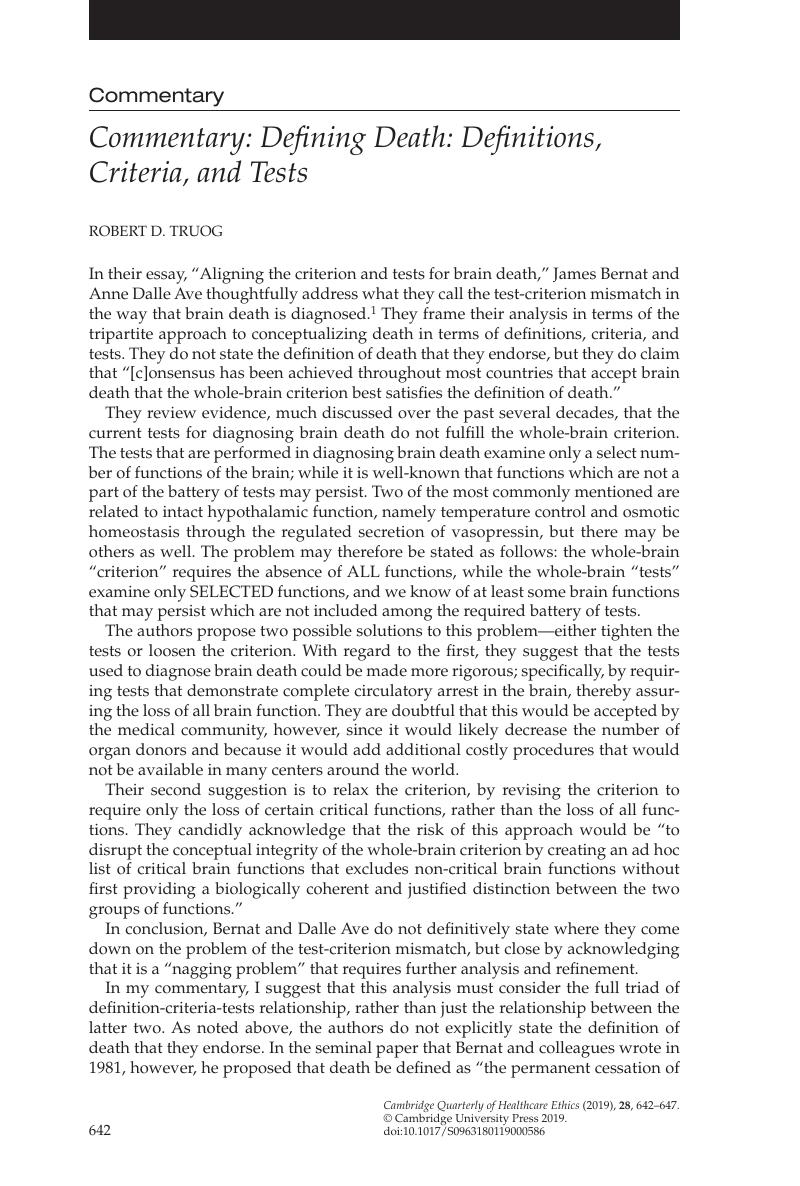Article contents
Commentary: Defining Death: Definitions, Criteria, and Tests
Published online by Cambridge University Press: 17 September 2019
Abstract

- Type
- Commentary
- Information
- Cambridge Quarterly of Healthcare Ethics , Volume 28 , Special Issue 4: Clinical Neuroethics , October 2019 , pp. 642 - 647
- Copyright
- Copyright © Cambridge University Press 2019
References
Notes
1. Bernat, JL, Dalle Ave, AL. Aligning the criterion and tests for brain death. Cambridge Quarterly of Healthcare Ethics, 2019;28(4):635–41.Google Scholar
2. Bernat, JL, Culver, CM, Gert, B. On the definition and criterion of death. Annals of Internal Medicine 1981;94:389–94, at 390.CrossRefGoogle ScholarPubMed
3. See note 2, Bernat et al. 1981, at 390.
4. Gross, CG. Claude bernard and the constancy of the internal environment. Neuroscientist 1998;4:380–5.CrossRefGoogle Scholar
5. Cannon, WB. The Wisdom of the Body. New York: The Norton Library; 1932.CrossRefGoogle Scholar
6. See note 2, Bernat et al. 1981, at 390.
7. Burkle, CM, Sharp, RR, Wijdicks, EF. Why brain death is considered death and why there should be no confusion. Neurology 2014;83:1464–9.CrossRefGoogle ScholarPubMed
8. Wijdicks, EFM. Deliberating death in the summer of 1968. New England Journal of Medicine 2018;379:412–5.CrossRefGoogle ScholarPubMed
9. Shewmon, DA. Chronic “brain death”—meta-analysis and conceptual consequences. Neurology 1998;51:1538–45.CrossRefGoogle ScholarPubMed
10. Repertinger, S, Fitzgibbons, WP, Omojola, MF, Brumback, RA. Long survival following bacterial meningitis-associated brain destruction. Journal of Child Neurology 2006;21:591–5.CrossRefGoogle ScholarPubMed
11. Shewmon, DA. Spinal shock and brain death’: Somatic pathophysiological equivalence and implications for the integrative-unity rationale. Spinal Cord 1999;37:313–24.CrossRefGoogle ScholarPubMed
12. The president’s council on bioethics. Controversies in the Determination of Death: A White Paper of the President’s Council on Bioethics, December 2008, at 40.Google Scholar
13. Veatch, RM. The whole-brain-oriented concept of death. An outmoded philosophical formulation. Journal of Thanatology 1975;3:13–30, at 15.Google ScholarPubMed
14. See note 2, Bernat et al. 1981, at 390.
15. Academy of medical royal colleges. A Code of Practice for the Diagnosis and Confirmation of Death . 2008; available at http://www.aomrc.org.uk/reports-guidance/ukdec-reports-and-guidance/code-practice-diagnosis-confirmation-death/ (last accessed 26 Feb 2019).Google Scholar
16. Shewmon, DA. False-positive diagnosis of brain death following the pediatric guidelines: Case report and discussion. Journal of Child Neurology 2017;32:1104–17.CrossRefGoogle ScholarPubMed
17. Shewmon, DA. The case of jahi mcmath: A neurologist’s view. Hastings Center Report 2018;48 Suppl 4:S74–S6.CrossRefGoogle ScholarPubMed
18. Hornby, K, Hornby, L, Shemie, SD. A systematic review of autoresuscitation after cardiac arrest. Critical Care Medicine 2010;38:1246–53.CrossRefGoogle ScholarPubMed
- 2
- Cited by




